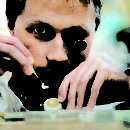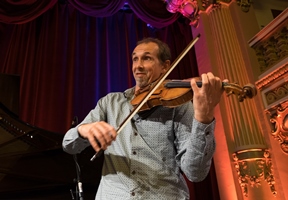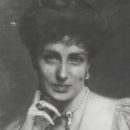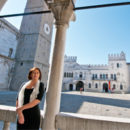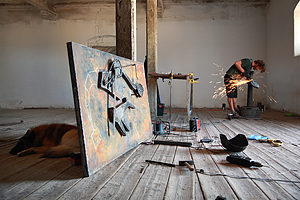
Joana Greveres – Living through art
Determination in building an intelligent and realistic framework for the development of Romanian contemporary art in an international context; Generosity shown in laying down a path for the expression of such talent – meet Joana Grevers!
What do the Bucharest 418 Gallery, a property with a history full of romance and mystery from the banks of the Danube; Cetate (village) and the famous Guggenheim collections have in common? They are all elements of an imaginary puzzle that creates an image, a personality and a destiny. If at first these concepts seem slightly mystifying, they begin to unravel their meaning as the story progresses, a story woven into the very logic of the space so deeply connected to the Romanian myth sung in the ballad of Miorita; to a structure history respects; to the will of a remarkable human being and to authentic values. Joana Grevers is of Romanian origin, born and raised in Bucharest, in the Ioanid park area to be precise. She grew up surrounded by intellectuals of noble origin, truly special people, for whom resistance through culture represented a way of life at a time when communism was practically suffocating any natural manifestation that came from society.
She left the country with her family in 1974 and settled in Munich, Germany; she then studied medicine and practiced until 2004. Hopelessly in love with beauty, but perhaps also influenced by the environment she lived in, she travelled to Italy, the home of art and patron muses. And since nothing happens by chance, through a miraculous sequence of events Joana decided to study Art History, studies that culminated with a PhD. 2008 was a decisive year for her career as she became a member of the Peggy Guggenheim Advisory Board, the prestigious institution that from that moment on left its stamp of approval on her life. The same prodigious year saw Joana open 418 Art Gallery in Bucharest, at 12 Armasului Street. It is important at this point to note that Joana had already returned to her native country four years prior to this opening, namely in 2004, to look for and rediscover places, memories, family roots and childhood friends.
Heiress to the Barbu Drugă family, she recovered and saved from de struction the family mansion and adjacent property of Cetate in Dolj county. Ștefan Barbu Drugă is a true legend, a man with a great personality to match. His remarkable astuteness led him to bring to his vast estate these latest achievements that ensured the smooth running of things. The grinding mill which saw its grains go the farthest corners of Europe was a true gem, while the miraculous gearing of the time supplied, as the documents of the era confirm, flour to the famous pastry shops of Vienna. The property was also endowed with a port that loaded ships with the riches of this blessed land, wisely used ships that lazily floated on the not so blue Danube waters. Barbu Drugă’s name is linked to other numerous modern improvements he brought to the area, as are the care he showed to the local people and his many acts of kindness, acts recorded in the documents of the time or transmitted from generation to generation.
All that remains today of the splendour of those sadly bygone times is an elegant mansion, its outbuildings, the baroque park, barns and the stables that once housed a famous herd of horses. The site itself has an interesting story that started in 1874 and continued into the next century. The building has a precise geometry done to match somewhat the tastes of the time, a rectangular shape with two main entrances to the north and south designed like a portico. In the basement, one of a very generous size, there was a storage space communicating with the ground floor through a wooden staircase.
Full interview



